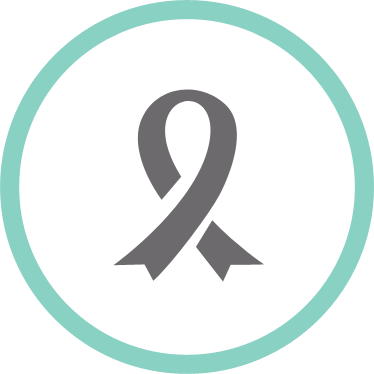Aside from breast cancer, our services cover other breast related problems, such as breast reconstruction surgery, axillary lymph node dissection, and sentinel lymph node biopsy.
Breast cancer is one of the main causes of cancer death in women around the world and is the most frequently-found cancer among Thai women. The Breast Conservation Center, Nonthavej Hospital, is ready to provide breast care with the specialized medical team, comprising breast surgeons, radiologists, anesthesiologists, cancer internists, pathologists and breast cancer interdisciplinary teams. We provide consultation on disease screening as breast cancer is most treatable when it is detected early.
Services
- 1. Digital mammogram is breast cancer screening by x-ray which captures images of the internal structure of the breasts. As a regular body examination may not find first stage abnormalities, mammographic pictures can show the different densities of the different tissue types, such as breast tissue, arteries, fat, calcification resulting from early stage ductal carcinoma, tiny tumor, or it may serve as follow-up examination after surgery.
- 2. Breast ultrasound is breast examination performed by radiologists. High-frequency sound waves produce detailed images inside the breasts to diagnose breast abnormalities in young women, or it may serve as an extra examination in addition to a mammogram. In case of high-density breasts, an ultrasound is used to indicate and localize cysts.
- 3. Breast examination by breast surgeon
- 4. Self-breast examination, categorized into 2 types;
- 4.1 Spiral Method starts on the upper part of the breast. Move your fingers in circles to find a hard lump or mass. Rotate your fingers in circle at least 3 times until your fingers reach the nipple. Repeat the spiral movement twice. Press with your fingers gently the first time, then press harder the second time.
- 4.2 Grid Method starts by dividing the area from collar bone to under the breasts and armpit and to the sternum bone in a check-board pattern. Move your fingers in circles. Gradually increase the pressure. Repeat the same movement in the next grid until you complete the whole breast.
- 5. Fine Needle Biopsy is a sampling of breast tissue for examination. The physician inserts a fine needle into abnormal appearing lumps or masses. The tissues are later examined by pathologists to determine whether they are normal or cancerous cells.
- 6.Core Needle Biopsy is removal of suspicious tissues from the breast by automatic biopsy gun, without surgery. The tissues are later examined by pathologists.
- 7.Needle Localization Biopsy is localization of suspicious breast tissues or abnormalities by using very thin needles, in case they cannot be localized by x-ray machine. Then, the tumor or early-stage cancer cells are removed from the breast.
- 8.Breast cancer surgery is divided into 2 steps;
- 8.1 Breast surgery
- 8.1.1 Mastectomy is the surgical removal of the entire breast, including the areola, as a total preventive measure.
- 8.1.2 Breast conserving therapy is the surgical removal of the cancer, while conserving the healthy breast tissue. Breast conserving therapy is performed together with radiotherapy (every day for a period of approximately 5 weeks) to achieve the same result as the mastectomy method.
- 8.1.3 Breast Reconstruction (TRAM Flap, LD Flap) is categorized into 3 types;
 Breast reconstruction surgery with TRAM flap is breast reconstruction using lower abdomen muscle and skin (TRAM flap). The reconstruction is for patients undergoing mastectomy and can be performed at the same time or after cancer removal.
Breast reconstruction surgery with TRAM flap is breast reconstruction using lower abdomen muscle and skin (TRAM flap). The reconstruction is for patients undergoing mastectomy and can be performed at the same time or after cancer removal. Breast reconstruction surgery with LD flap is breast reconstruction using Latissimus Dorsi muscle and fat (LD flap) from the patient’s back. In some cases, breast conserving therapy removes large amounts of tissue and deforms the breast. Breast reconstruction surgery with LD flap aims to make both breasts look the same.
Breast reconstruction surgery with LD flap is breast reconstruction using Latissimus Dorsi muscle and fat (LD flap) from the patient’s back. In some cases, breast conserving therapy removes large amounts of tissue and deforms the breast. Breast reconstruction surgery with LD flap aims to make both breasts look the same. Breast reconstruction surgery with silicone is for breast reconstruction after breast cancer surgery.
Breast reconstruction surgery with silicone is for breast reconstruction after breast cancer surgery.
- 8.2 Axillary lymph node dissection: In the past, cancer patients who underwent axillary lymph node dissection could experience side effects of swelling and numbness in the arms and legs. However, a new option is available;
 Sentinel lymph node biopsy: Sentinel lymph node biopsy aims to detect the spread of cancerous cells to the sentinel lymph node. If the examination finds no cancerous cells, axillary lymph node dissection is not required.
Sentinel lymph node biopsy: Sentinel lymph node biopsy aims to detect the spread of cancerous cells to the sentinel lymph node. If the examination finds no cancerous cells, axillary lymph node dissection is not required.
- 8.1 Breast surgery





